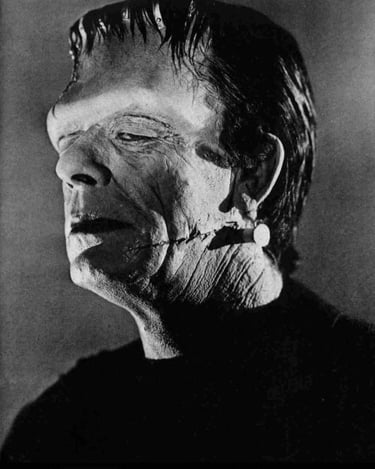House of Dracula (1945)
“Do you doubt the supernatural?” – Count Dracula


It was 1945 And with WW2 over, perhaps audiences had seen enough horror. Universal brought their continuing series of gothic monster movies to an end with another crossover featuring the Trinity of Terror who had all come together in the previous year’s House of Frankenstein.
This has everything thrown into the mix. But not everything is picked up quite the same as we had left it at the end of the prior movie. At the clifftop castle home and laboratory of Dr Franz Edelmann (Onslow Stevens), an unexpected guest arrives in the early hours of the morning, calling himself Baron Latos – in reality Count Dracula (John Carradine) inexplicably back from the dead – again.
Dracula wants to be cured of his vampiric affliction and seeks the help of Edelmann, who agrees to a series of blood transfusions. (Uh oh)
Also in the area is the ever morose and pouty Laurence Talbot (Lon Chaney) who has inexplicably survived the silver bullet from last time. He too wants a cure from Edelmann. Seeing him in police custody transforming in to the Wolf Man, Edelmann theorises that the transformation isn’t triggered by the full moon, but by cranial pressure. Luckily, Edelmann has just the thing – a flower whose spores can be used to soften bone, which means Talbot might be cured without surgery – but he doesn’t have anywhere near enough of the plants to affect a cure.
Talbot throws himself off the cliff in a fit of despair, but doesn’t die – he’s carried by the sea into a cave under the castle and when Edelmann goes to look for him, he and Talbot find the body of the Frankenstein Monster (Glenn Strange), perfectly preserved and alive, having been carried there by the quicksand. But in an amazing discovery, it’s found that the cave is the perfect temperature for growing the bone softening spores. So, good news – right?
The bad news is that Dracula is busy seducing one of Edelmann’s nurses with the intention of turning her into a vampire. Edelmann insists upon another transfusion, but Dracula switches the flow, so the kindly doctor gets a full dose of Transylvanian red. When he wakes up, Edelmann exposes Dracula to the rays of the morning sun, turning the Count to dust. Out for the Count, you might say.
But the transfusion has had the effect of turning the kindly old Edelmann into a Jekyll and Hyde character who becomes obsessed with the idea of reviving the Frankenstein Monster and with him as his muscle, ruling the world. (Again, uh-oh).
Good Edelmann carries out the procedure on Talbot, while bad Edelmann starts killing people and charging up the Monster. The villagers angry at Edelmann’s murder of one of their own whip up into a frenzy and storm the castle, as the moon rises and we see Talbot IS finally cured. As they reach the castle, the recharged Monster breaks free and clumsily pushes over a table of chemicals which spontaneously ignite. Talbot saves the day by shooting the evil version of Edelmann and ushering out the villagers while the Monster and Edelmann burn to death.
There really wasn’t anywhere to go after this film. The Monsters are bit part players only with the exception of Talbot who was cured, thus bringing his arc to an end. Dracula’s only there to move the plot along so Edelmann can become evil and the Frankenstein Monster isn’t even revived until three minutes before the end of the film, so he’s just a prop – a means of setting fire to the lab and finishing the film off. He has literally nothing else to do and serves no other purpose.
But at least Larry Talbot got to watch the moon rise and didn’t get growly and hirsute.
The Gothic age of Universal Monsters had come to an abrupt end. The world was changing, and was barely recognisable from the one in which Bela Lugosi had menaced Dwight Frye in the steps of Castle Dracula in 1931.
The atomic age was upon us, but the studio wasn’t done with monsters just yet…
